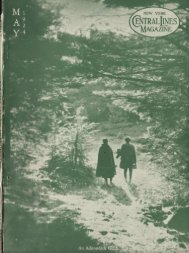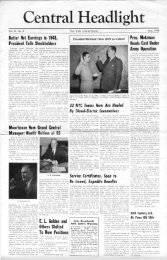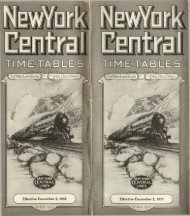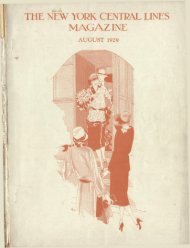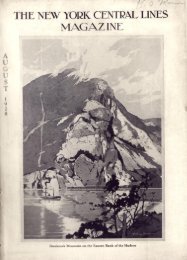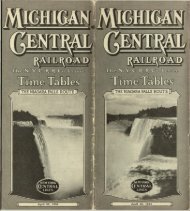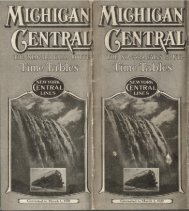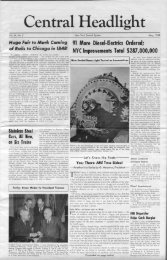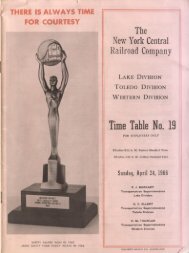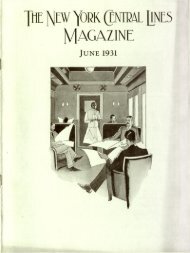You also want an ePaper? Increase the reach of your titles
YUMPU automatically turns print PDFs into web optimized ePapers that Google loves.
96<br />
Toggle lever, connection*, and method of obtaining equalized shoe pressure.<br />
New York Central Lines Magazine for May, 1928<br />
New York Central Lines Magazine for May, 1928 97<br />
top of the shoes onto the rail at the<br />
end of the retarder.<br />
The retarder requires but one adjustment<br />
to compensate for shoe wear.<br />
This adjustment is made on the toggle<br />
lever and consists of the lengthening<br />
out on a rod as shoe wear increases.<br />
Shoe beams, made of alloy steel, furnish<br />
ample protection to the retarder<br />
from low hanging column bolts or<br />
dragging equipment. All parts are<br />
heavier so as to withstand the shock<br />
of continued service and with an individual<br />
pressure oiling system the<br />
proper lubrication and long life of<br />
operating parts is insured.<br />
Operation and Performance<br />
Switch-lists of all inbound trains<br />
are written on a Morkrum "Teletype"<br />
machine in the yard master's office and<br />
reproduced simultaneously in the<br />
hump office and the two retarder control<br />
towers. Loudspeaker telephones<br />
connect the hump with both towers<br />
for instant communications between<br />
the conductors and operators. Pneumatic<br />
tubes are being installed to facilitate<br />
the sending of bills and train<br />
lists from the receiving yard to the<br />
yard office and from there to the outward<br />
yard clerk. The yard is lighted<br />
throughout its length by flood lights<br />
on towers so located as to throw the<br />
light lengthwise of the tracks.<br />
The regular humping crew consists<br />
of one engine on the first trick, two<br />
engines on the second trick, and one<br />
engine on the third trick. There is a<br />
conductor and a helper with each engine,<br />
who do their own cutting of cars<br />
at the top of the hump and their own<br />
trimming. The humping engine in<br />
addition to the humping of cars, "cabooses<br />
and doubles" the outgoing<br />
trains, "switches" the transfer and<br />
repair tracks and makes the deliveries<br />
to the Delaware & Hudson.<br />
The entire operation of the switches<br />
and car retarders is controlled from<br />
two towers, so arranged that one man<br />
in a tower can normally handle the<br />
work, or two men can operate in each<br />
tower, dividing the work as peak<br />
periods require. All trains depart<br />
direct from the classification yard, as<br />
there was no opportunity to provide a<br />
departure yard. However, four leads<br />
are provided for doubling trains together,<br />
as the majority of trains go<br />
out with more than one classification.<br />
During the short time in which the<br />
car retarder system has been in service,<br />
freight traffic has been light;<br />
therefore, the record of performance<br />
does not reflect the true capacity of<br />
the yard. Operation so far, however,<br />
indicates a humping speed of 125 cars<br />
per hour with one operator in each<br />
tower, and 200 cars per hour with an<br />
additional operator in each tower.<br />
On Monday, January 9, Mechanicville<br />
Yard, operating at less than 50<br />
per cent of its capacity, handled 1,227<br />
cars. Picking an item from the January<br />
9 record; a seventy-two-car train<br />
arrived at 11:33 A.M., was listed for<br />
switching at 12:21 P.M., was "high"<br />
at 12:40 P.M., and complete at 1:01<br />
P.M. This performance shows an<br />
average humping speed of 18 seconds<br />
per car.<br />
The operation to date has shown a<br />
decrease in yard costs of about 40 per<br />
cent; a decrease of 50 per cent in the<br />
time cars are held in the receiving<br />
yard and a material reduction in damage<br />
to cars in humping; and it is believed<br />
that the combined net annual<br />
savings will be in excess of 50 per<br />
cent of the cost of the entire work of<br />
providing the added facilities.





